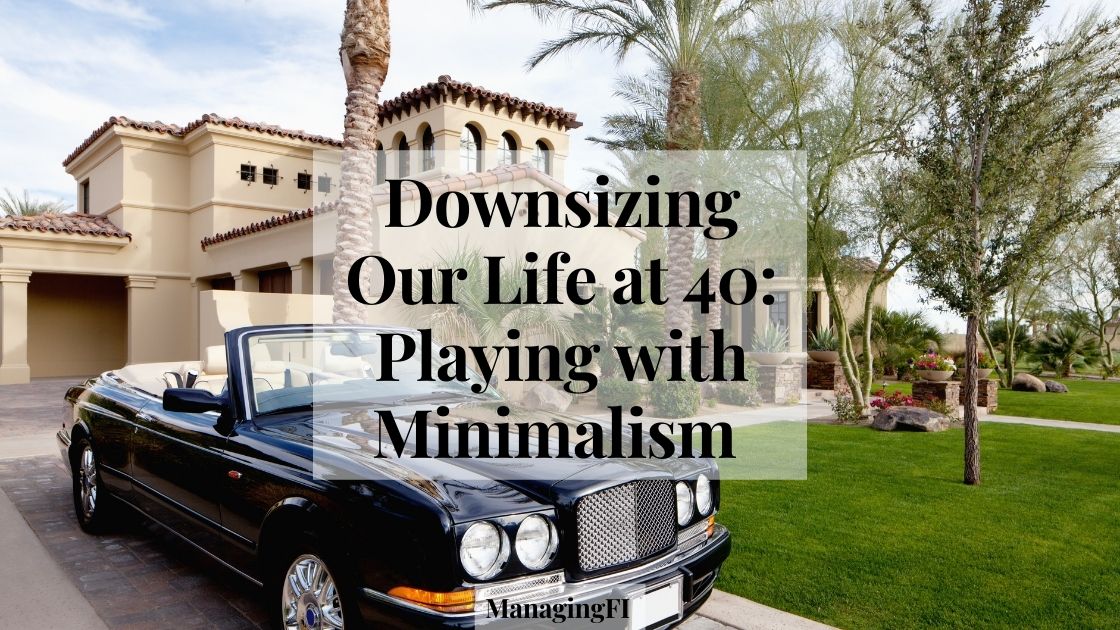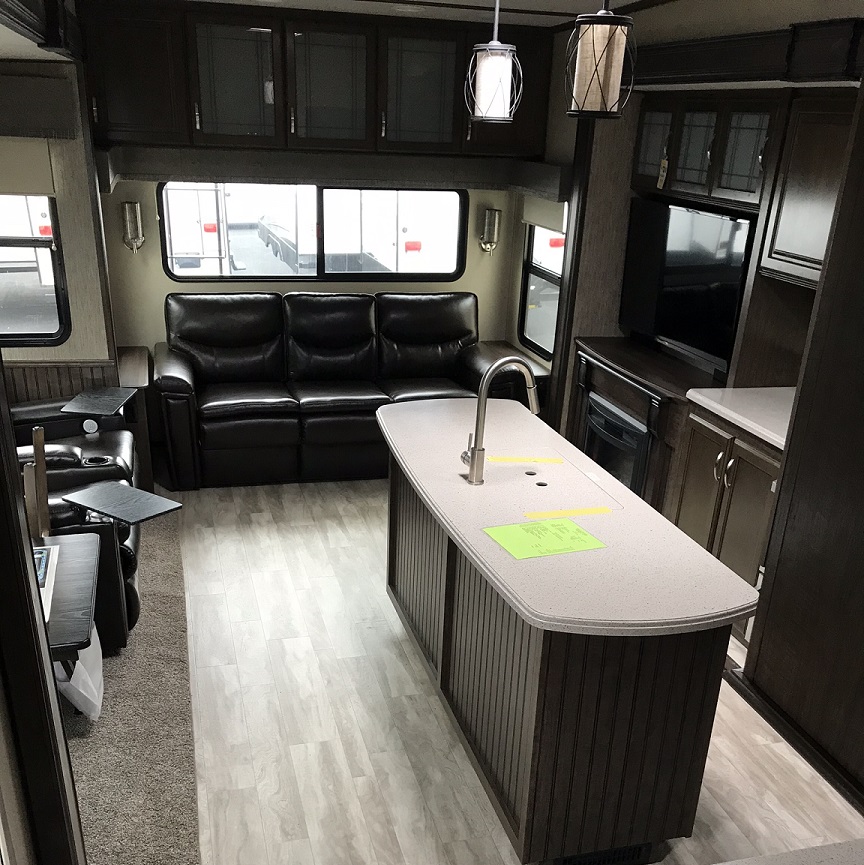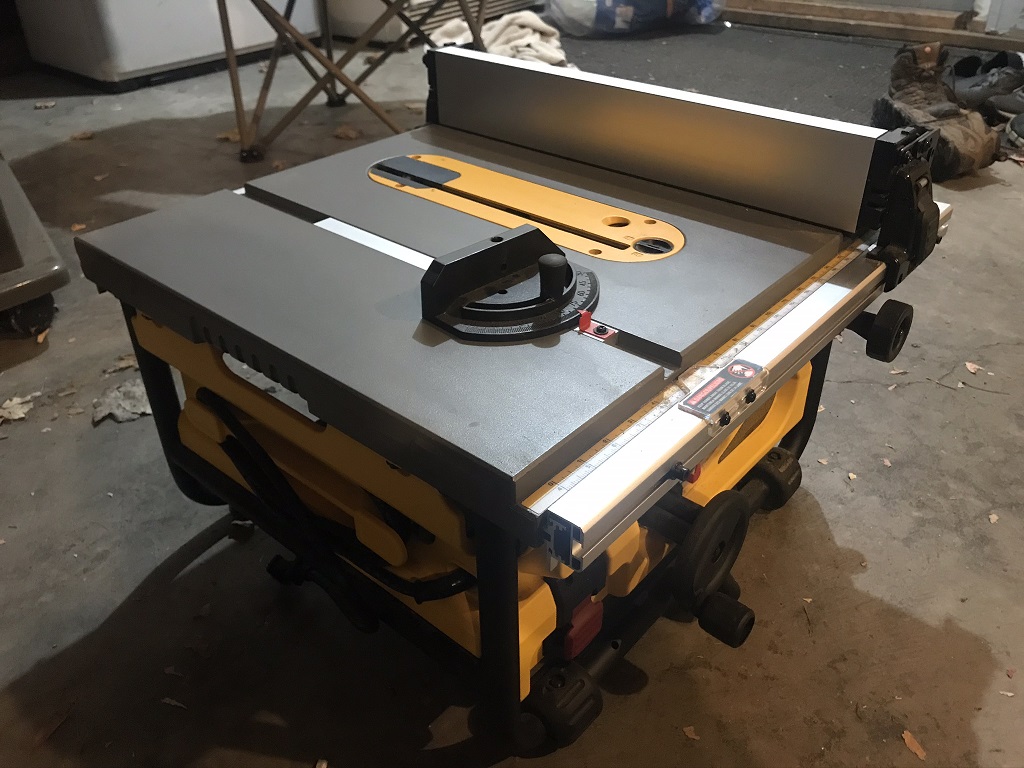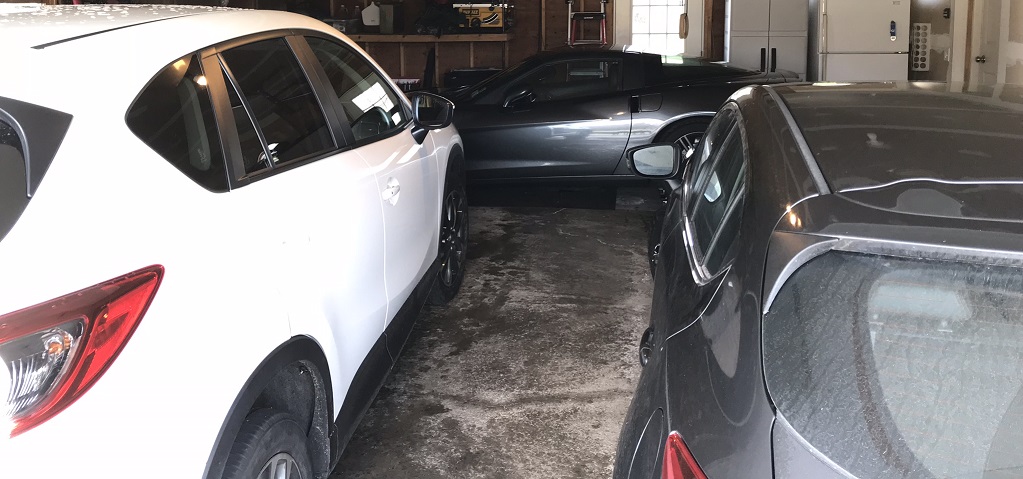BLUF: There’s no one sized fits all advice for whether you should combine your finances or keep them separate. What’s important is that the couple trusts each other, is aligned on their long term financial goals and have a plan to manage the day to day money. If you get that right I don’t think it matters if you merge your accounts or keep them separate.
For better or worse, money is a large part of life. A lot of our time and energy is spent working jobs to make money and then spending it in some way to live. It’s a source of emotions in our lives. Stress when we don’t have money and gratitude and happiness when we have enough to be free to do as we’d like.
Many of us want to share our lives with another person through some form of a relationship. Only naturally then, at some point during your life, there’s probably going to be a crossroads where your life is going to be combined with another persons in a relationship. But what about the money?
Relationship Finance Decisions

There are many decisions to be made when joining two peoples lives together and one common source of stress and potential conflict is how their financial lives should work as a couple. It’s not surprising as there are a lot of decisions to make and questions to answer:
- Should you combine all your bank accounts?
- Should you have a common checking account that all paychecks go into?
- How do you split responsibility for paying the bills? 50/50?
- Does each person get their “own” money? If so, how much?
- When do you have to ask for permission to spend money?
I come at this topic from a unique perspective because Mrs. MFI and I actually have ZERO shared accounts even though we’re married. Some would call that crazy and not the way that a married couple should handle their finances. I would challenge that idea and say that there’s no one size fits all approach to making a couples finances work.
This article is going to explore this topic of finances in a relationship. I’ll talk about how Mrs. MFI and I make ours work and walk through a framework for thinking through how to make things work best for you in your own relationship.
Our Story: For Richer or Poorer, Our Finances are Apart

It’s by pure coincidence that I happen to be writing an article about combining financial lives around our wedding anniversary. Mrs. MFI and I started dating in our early 30’s and were married around 35 years old so we had fairly established financial lives as individuals at that point. I was divorced at 30 and had gotten used to paying for a house and everything in my financial life on my own. Mrs. MFI had her own apartment, job and savings when we started dating. As a product of her upbringing she’s always been quite frugal and saver.
Mrs. MFI eventually moved into my house which naturally brought up the conversation of splitting bills, what she should pay and it should be paid. There’s an important variable in this equation though. I make a lot more money than Mrs. MFI. Probably 2.5x as much as her at the time. All the bills were in my name and I was on top of the bills so she would write me a check for about 1/3 of the household bills and I paid the other 2/3rds.
A Strategic Decision To Maximize Our Savings
My mom dying, our marriage and Mrs. MFI’s strong saving habits really pushed me to start saving more and got us talking about the right choices for our future. I was geeking out more with personal finance which included learning more about retirement accounts, investing, compounding and tax optimization.
After learning more about the benefits of a 401k, Roth’s and HSA’s we decided that it should be a goal to try and max out all of these accounts. There was a catch though. For Mrs. MFI to do that it would be about 60% of her gross income! She’s quite frugal but it wouldn’t have been possible (or reasonable) for her to do that while paying 1/3 of the household bills let alone other personal expenses like car insurance, gas, vacations, etc. We were making $150k together at this point so there was substantial tax savings to be had by maxing out those pre-tax buckets.
We made the team decision that to reach our long term goals, I would take on all of the household expenses, gas, insurance…etc. Basically everything short of Mrs. MFI’s personal spending and gift giving. After that our accounts and responsibilities looked like this:
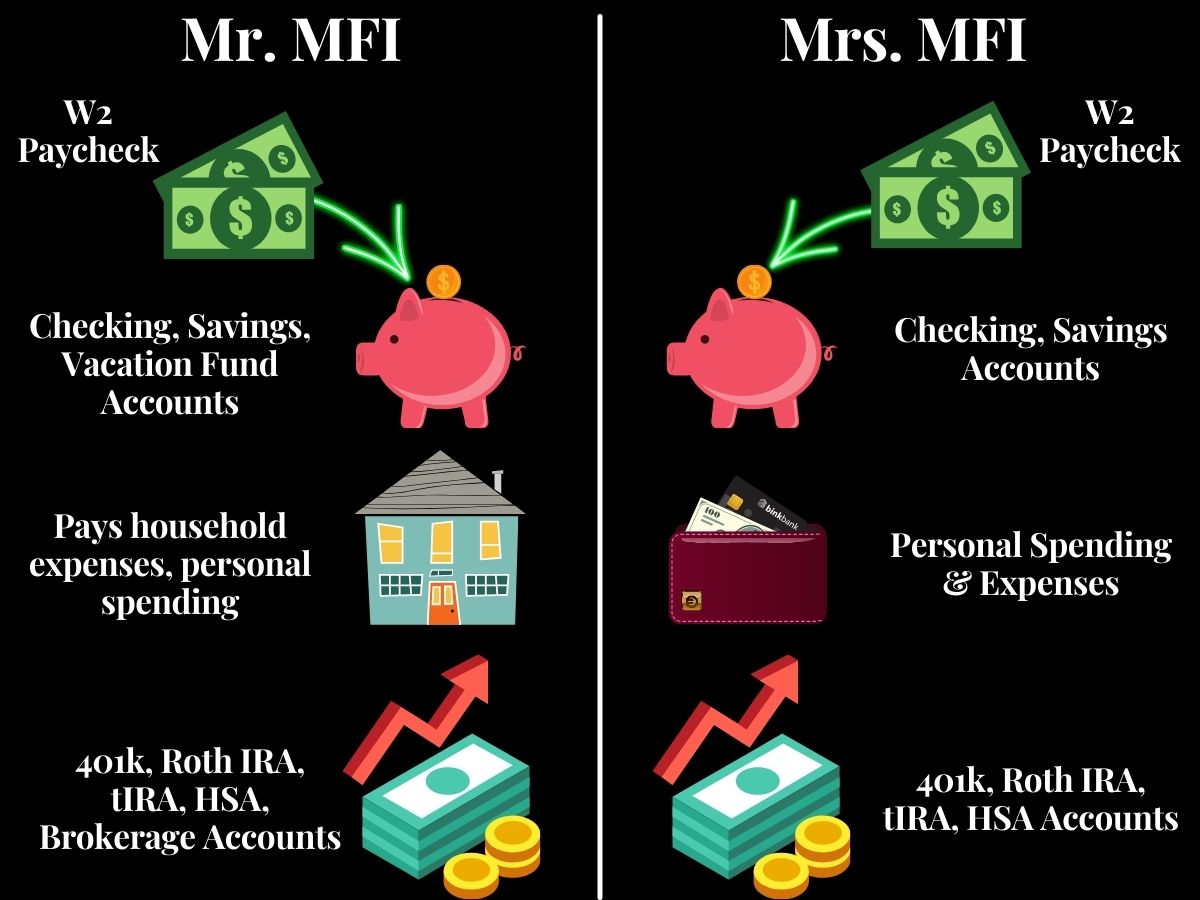
Mrs. MFI being an independent person had a really tough time with this. She felt like a mooch at first and maybe a little bit to this day.
However, this move has really accelerated our retirement savings and saved us a ton in taxes from the 22% tax bracket. $19,500 for each 401k * 2 and $3,600 * 2 for each HSA. Saved us ((19,500 * 2) + ($3,600 * 2)) = $46,200/year. At the 22% tax bracket if we took that as income and just saved it in a brokerage account we would pay $10,164/yr in federal tax on that money and only be putting in $36,036 ($46,200 – $10,164).
Our Split Finances Continue
From there on out it made even less sense to get a joint account. I’m on top of the bills paying everything that is our living expenses and Mrs. MFI is basically saving and investing 90% of her gross pay. Sure, we could both dump our paychecks into a joint checking account but it wouldn’t buy us anything at this point. Our system works and we trust that each of us are doing our part to work towards are larger savings goal of FI.
Our brokerage account is the one account that has a mix of money that we have both contributed towards and that will eventually get turned into a joint account. That’s just a paperwork change at this point.
Mrs. MFI is an authorized user on my Amex Cash Preferred that we use for 6% back on groceries and 3% back on gas as well as my Citi DoubleCash. That lets her easily charge normal household spending to those cards which I manage and pay.
A Framework for Relationship Finances

In figuring out what works for us I’ve realized that what works for each couple is going to be different. Each individuals money behaviors and mindsets are a complex mix of the world that we grew up in, what our parents taught us and the financial experiences that we’ve had along that way.
All of those things make each individual person have a unique perspective on money management. By extension each couple is going to need to figure out the individual approach that works for their team of two.
To help you come up with a system that works for your household here’s a framework of questions to walk through to help figure this out for yourself. This helps to ensure that you have a plan for the role that each person will play, how you will manage the day to day expenses and how all of that contributes to your long term goals.
- Understand each persons long term goals.
It’s important to talk through what each partners long term goals are so that you can figure out a plan that will work for both people. If one person wants to retire early and the other person wants to live for the day spending everything then there’s going to be a lot of financially induced conflict in the relationship.
Talk through the specifics of what each person wants and any goals that they have. What does your dream life look like? If you think you want to travel the world being nomadic then you may make very different decisions along the way than if you want to buy a huge house near your kids and have all the grandkids come over.
Having a long term goal gives you a north star to guide your decisions and keep you tracking to something. It can certainly change over time, but you need to work towards something.
- Discuss how each persons spending wants and wishes
Every person is going to have certain things that they like to spend their money on. Some people like horses. Some people like fast or fancy cars. Some people like elaborate vacations and travel. Some people like fancy clothes, jewelry or watches. Some people love personal care treatments like skincare, hair, nails or massages.
As the Afford Anything podcasts says, you can afford anything but not everything. For items that are major cost drivers in the budget each person needs to be able to put their desires on the table so that you can come up with a line in the budget for it.
- Understand each persons strengths and weaknesses and figure out your money roles

Both people have a vested interest in the finances of a relationship. However, not everyone is good at the different skills required to track spending, pay bills on time and get money invested.
See if one person is more suited for one or multiple of these roles. If one person is already good at it and wants to do and the other doesn’t then it’s an easy decision. If you want to split the role that’s fine too but often one person likes to take the lead.
- Keep accounts separate or have joint accounts?
Most will come into a relationship with their own checking and savings accounts at a minimum so you need to discuss if you’re going to have separate accounts or join them. The main place to start is with a checking account as you need to decide if you want all bills paid from one joint account, completely separate accounts or some hybrid.
If you aren’t sure where to start, begin with something easy and talk through how it would work. If you opened up a joint checking how much of each persons paycheck would go in there per paycheck? What expenses will be paid from that account?
- Create a plan for how things will work day to day, week to week. Talk through it in detail!
It’s really important to have a common understanding of how the finances are going to work on a day to day and week to week basis. How much of each persons paycheck will be put towards the household bills? Will each person be expected to save a certain amount? Does each person get their own spending budget of money that they can do whatever they want with no permission required? Is their a dollar amount for a purchase where the couple is expected to discuss it before the purchase is made?
- Give things a try!
Don’t spend forever agonizing over each detail only to never really get started. It’s okay to not get a perfect understanding of how things will work at the beginning but be prepared to track your spending and talk through and questions that come up regarding spending that the other person has.
The faster you can come up with a system that works for both people, the faster that you will have a system that just happens so each person knows what to expect. Jumping in and getting started will expose any holes in the plan. Predictability = efficiency and conflict avoidance.
- Make a plan to meet regularly to talk about what’s working, what’s not.
It’s important to meet regularly, probably weekly at first, to review the spending and how the system is working. That gives each person an opportunity to see how things are going and discuss any issues. As you find a groove you can meet less often but I’d recommend at least quarterly.
- If something isn’t working, make a change and repeat.
Plans are great but they’re just a starting point. Don’t be married to a plan no matter how much work went into it. If something isn’t working anymore, sit down and figure out how to change it!
The Framework – Applied to Our Situation
I think it’s helpful to see an example of the framework in action so here it is applied to Mrs. MFI and I.
- Understand each persons long term goals.
Fortunately Mrs. MFI and I are on the same page that FI so that we have security and the option to leave our office jobs and travel is very important to us. We both love to travel so we’re working towards some period of time to try out nomadic living and see where we might want to live more permanently someday. Upstate NY has a lot of snow and not much sunshine so we’d like to move away from that. Oh, and the awful taxes (we pay $5,600/yr in taxes on a $150,000 house).
Because of that FI and nomadic goal we’re downsizing a lot of our stuff and being very careful about what we buy. Fortunately we’re not that materialistic anymore so that isn’t a huge challenge.
- Discuss how each persons spending wants and wishes
The largest line item of spending for us both is travel. We budget about $6,000 a year for vacation. Our entertainment budget is about $3,600 a year and it’s mostly stuff that we do together. I enjoy spending money on fitness related events like running races and the shoes that go with them. Mrs. MFI spends money on craft related things.
- Understand each persons strengths and weaknesses and figure out your money roles
It’s probably not a huge surprise that the guy writing the personal finance blog is taking the lead on the household finances. I’m the CFO and Mrs. MFI is chairman of the board in our two person company. What does that mean? She has oversight of the budget, the spending and how we’re doing to plan and I’m the one making it happen. I track the spending using YNAB, budget with YNAB, calculate our FI number and leads our travel rewards efforts.
- Keep accounts separate or have joint accounts?
As previously mentioned, we have basically separate everything for our accounts. But each person knows about all of the accounts and can see what’s in them whenever they want. There are no hidden accounts.
- Create a plan for how things will work day to day, week to week. Talk through it in detail!
Each of our paychecks go into our individual checking accounts. I handle all of the household bills from my checking account and use YNAB to manage the spending and budgeting every two weeks. I also pay our credit cards that are used for the household expenses every two weeks. We have a single account travel fund that all travel expenses come from.
We each have savings accounts that make up the more liquid portion of our emergency fund although most of it is invested in our brokerage account. You can read about my 3 tier emergency fund here.
If either of us are going to spend more than $100 on something we talk to the other person about the purchase unless it’s a gift.
Action Steps:
- Walk through the framework with your partner and answer each question. If there’s disagreement – great! Get it out on the table and figure out a compromise. Better to figure out the issues early on.
- Meet regularly and check in with each other. How is it going? It’s critical that you’re honest with each other if something isn’t working.
- If something isn’t working, make a change! Life changes. People change. Your plan and systems are going to need to change based on the season of your life. Don’t resist change, embrace it.
Like the content? Click here to subscribe to the e-mail list and have the articles delivered to your inbox.


